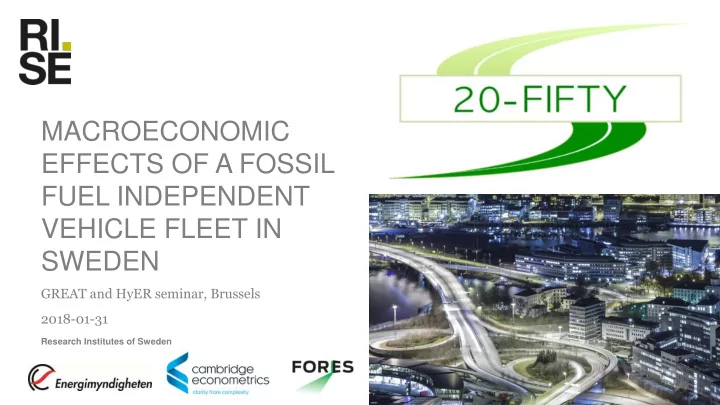

MACROECONOMIC EFFECTS OF A FOSSIL FUEL INDEPENDENT VEHICLE FLEET IN SWEDEN GREAT and HyER seminar, Brussels 2018-01-31 Research Institutes of Sweden
I NTRODUCTION ▪ Background ▪ 1/3 of CO 2 emissions originate from the transport sector ▪ 80% of oil consumption is used in road transport ▪ Political agreement on goals: ▪ Reduce CO 2 impact from domestic transports by 70% until Research questions: 2030 ▪ What technology pathways are possible? ▪ Fossil fuel independency by 2045 ▪ What are their effects on Swedish economy? ▪ Project ▪ Explores different technology pathways for fossil independency for the Swedish vehicle fleet and their effects on the Swedish economy 2
T HE MODELS ▪ Vehicle Stock Model Partial model, based on annual vehicle ▪ cohort Includes passenger cars, buses and heavy ▪ goods vehicles Assumptions on future development of ▪ technology, power trains and fuel types ▪ E3ME ▪ Econometric (non-equilibrium) model ▪ Input/output model ▪ Complete integration of energy and economy modules ▪ 53 regions, 77 economic sectors 3
G ENERAL ASSUMPTIONS ▪ New vehicle sales are kept constant at 2015 year’s level ▪ Vehicle life time is calibrated from historical data ▪ Sweden’s competitiveness regarding vehicles is assumed constant vs the rest of the world ▪ There will be a full list of assumptions in the Project report ▪ All expenses are financed by “the market”. ▪ Public finances always in balance ▪ Investments do not crowd out other investments ▪ Assumptions regarding oil prices and electricity price and mix are based on external sources 4
M ETHOD 1. Three technology scenarios, which reduce CO 2 impact by 80% (targets from an earlier report) BIO – Biofuel based ▪ ELEC – Battery electricity based ▪ FCV – Fuel cell based ▪ ▪ All scenarios are based on biofuels, which can be mixed with fossil fuels ( drop in fuels ) 2. Update to Swedish policy development ▪ ELEC_BB – ” Biofuel quota ” policy and 70% reduction target Addition MaaS/car sharing ▪ Sensitivity analysis - oil and electricity price ▪ Sensitivity analysis - import of biofuels ▪ 5
A SSUMPTIONS FOR ” B IOFUEL QUOTA ” AND 70 % TARGET ▪ CO 2 reduction per year according to ” Biofuel quota ” Petrol: Diesel: ▪ NECESSARY pace of electrification (BEV + PHEV + HEV) per vehicle type 120 100 % of new 2020 2030 2050 car sales 80 Cars 60 90 100 60 Buses 50 70 80 Vans 50 100 100 40 LHGVs 50 100 100 20 MHGVs 12 25 55 HHGVs 0 0 0 0 2020 2030 Passenger cars Buses Vans LHGVs MHGVs HHGVs 6 6
A LTERNATIVE PATHWAYS TO 70% TARGET – E LECTRIFICATION PACE ▪ “Biofuel quota” levels ▪ More biofuel - less electrification ▪ Less biofuel - more electrification 120 120 100 100 90 80 80 80 70 60 60 60 50 40 40 40 30 20 20 20 10 0 0 0 2020 2030 2020 2030 2020 2030 Passenger cars Buses Vans LHGVs MHGVs HHGVs Passenger cars Buses Vans LHGVs MHGVs HHGVs Passenger cars Buses Vans LHGVs MHGVs HHGVs 7
M ACROECONOMIC R ESULTS – ” B IOFUEL QUOTA ” AND 70 % TARGET ▪ Results ELEC_BB (w 80% import) - relative to CPI ▪ Positive results for both GDP, consumption, 0,9 employment and investments, compared to CPI 0,8 0,7 0,6 ▪ Rational 0,5 0,4 ▪ Imported fossil fuels are replaced by domestically 0,3 produced fuel (electricity, biofuel) 0,2 ▪ Lower TCO for car owners results in increased 0,1 consumer expenditure and increased economic 0 activity across the economy GDP Consumer expenditure Employment 2030 2050 ▪ More investments in new infrastructure drive the demand side of the economy 8
S ENSITIVITY ANALYSIS – O IL AND ELECTRICITY PRICE Method Adjust the oil (1) and electricity (2) price upward and ▪ downward by 30% Results Standard scenario – based on IEA’s ▪ forecast Effects of (1), in terms of GDP ▪ ▪ Electricity price changes give the opposite results from oil price GDP w Oil price +/- 30% - relative to CPI changes 0,800% 0,700% 0,600% 0,500% 0,400% 0,300% 0,200% 0,100% 0,000% -0,100% -0,200% Standard (IEA) IEA -30% IEA +30% 11
S ENSITIVITY ANALYSIS – B IOFUELS ▪ Method ▪ 80% import (as today) has been compared to 100% Swedish production ▪ Results ▪ Domestic production results in increased positive economic ▪ Swedish production of biofuels is effects, compared to import (assuming equal cost structure) needed! GDP - relative to CPI 0,700 0,600 0,500 0,400 0,300 0,200 0,100 0,000 ELEC_BB (100% Swedish production) ELEC_BB (80% import) 2030 2050 12
L IMITATIONS ▪ Behavioural and societal changes ▪ Reducing road transport overall would help the transition ▪ Rebound effects – CO 2 ▪ Total GDP growth is more important for CO 2 emissions than the rebound effects from the measures in our study ▪ It is important to reduce the CO 2 intensity in all sectors ▪ Potential technologies ▪ Autonomous vehicles, hydrogen/fuel cells, electric roads, electro fuels 14
S UMMARY ▪ It is possible to reach the targets! ▪ A very speedy uptake of new technoclogies and new power trains is needed ▪ Drop in biofuels are needed – to impact the current vehicle stock ▪ Action is needed now! The effects can be positive for Swedish economy ▪ ▪ Technology development, cost efficient mobility and replacement of imported fossil fuels are driving this ▪ The price of oil and electricity impact how positive the results will be ▪ The level of import and the price of biofuel will also impact how positive the results will be 15
THANK YOU! Ann-Charlotte Mellquist ann-charlotte.mellquist@ri.se Tel: +46 702 656560 Research Institutes of Sweden
Recommend
More recommend